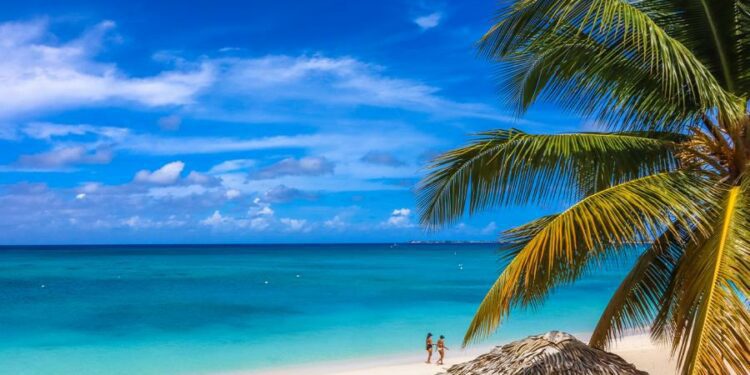Amphitrite mermaid statue at Sunset House.
Candice Landau
Sunset House
This site earned acclaim for the 9-foot-tall mermaid statue located 55 feet below the water’s surface just ten minutes offshore. Sculpted by Simon Morris, the statue called Amphitrite lures underwater photographers keen to get a shot of the bronze beauty. There’s plenty more to see, however, including barrel sponges, schools of angel fish, snapper and barracuda. Hogfish, stingrays and conch can be found in the sandier spots.
A coral restoration project sits on the northern edge of the reef. As the name suggests, this is the house reef of the Sunset House Resort. As such, amenities include a dive shop, easy ladder entry, a secure parking lot and restaurants for a post-dive bite or tipple.
Devil’s Grotto and Eden Rock
Just off the Georgetown harbor downtown sits Devil’s Grotto. This shoredive buzzes with activity for numerous reasons: easy water access through a ladder entry, a unique swim-through cave and a tunnel system. Additional assistance and gear are available at the onsite Eden Rock Diving Center.
Swimming through glittering grottoes pierced by shafts of light through gaps in the rocks overhead is a surreal experience that changes on every dive. Following openings in the labyrinthine cave system, you’ll encounter the optimistic presence of new coral growth along with angelfish, parrot fish, barracuda and big schools of silversides evading hungry tarpon.
Eden’s Rock, an adjacent dive and snorkel site, features a reef that stretches from the sandy sea floor to a mere ten feet below the water’s surface, allowing for shallow water exploration that’s suitable for beginner and intermediate divers. A maximum depth of 50 feet helps stretch your tank for a longer bottom time.
Living the Dream Divers shows clients the topography of Soto Reef, a favorite house reef on Grand Cayman.
Lauren Mowery
Soto’s Reef
Living the Dream Divers occupies the original building used by Bob Soto to open the island’s first dive shop in 1957. The nearby reef, named for Soto, was the house reef then as it is today, providing an ideal spot for the center’s training and orientation dives.
Easy access, a shallow depth of 40 feet and a lack of current make it an obvious choice for beginners, but swim-throughs, caverns and tunnels jammed with jacks and tarpon, provide endless interest for all experience levels. Macro photographers have plenty to shoot if they can spot the smaller critters like banded coral shrimp and arrow crabs.
Lighthouse Point Reef
Located at the northwest corner of the island in West Bay, Lighthouse Point is home to dive operator Divetech. The outfit runs guided tours, day and night dives, and rents gear for this easy-entry house reef. Well-marked for navigation, divers reach a mini wall at around 300 feet from the shore.
Due to frequent, nutrient-rich currents, abundant fauna visit the area from macro-life to larger schools of fish, eagle rays and the occasional hammerhead shark. Perhaps the site’s most notable draw, however, is the Guardian of the Reef, another bronze sculpture by Simon Morris sunk in 2014. Representing a mythological creature that’s half ancient warrior and half seahorse, the statue represents the importance of marine conservation.
Related Reading: Best Destinations for Advanced Diving
Sea Fan Reef at Cobalt Coast
Divetech offers shore diving on its Cobalt Coast location. Divers enter the water using a ladder at the end of the dock to explore exactly what the name implies: a spectacular mess of sea fans spanning the hard pan leading out to a mini wall. The mini wall starts at 40-50 feet and drops to 65-70 feet running along the sandy floor. The topography parallels Turtle Reef and boasts abundant wildlife like snapper and barracuda, as well as occasional sightings of nurse sharks. Look out for giant barrel sponges tucked inside the deeper channels, too. A restaurant, dive shop and parking lot provide security and amenities.
Source link : http://www.bing.com/news/apiclick.aspx?ref=FexRss&aid=&tid=67223a28f6e3403a80e72a64ac32f98b&url=https%3A%2F%2Fwww.sportdiver.com%2Fshore-diving-grand-cayman&c=144457470504973887&mkt=en-us
Author :
Publish date : 2024-10-30 01:57:00
Copyright for syndicated content belongs to the linked Source.












